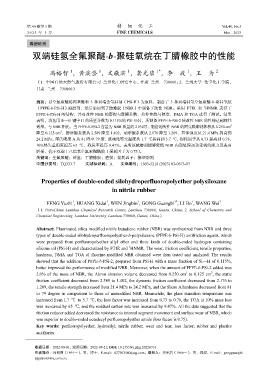Page 217 - 《精细化工》2023年第3期
P. 217
第 40 卷第 3 期 精 细 化 工 Vol.40, No.3
20 23 年 3 月 FINE CHEMICALS Mar. 2023
橡塑助剂
双端硅氢全氟聚醚-b-聚硅氧烷在丁腈橡胶中的性能
1
1
1
1
2
1*
冯裕智 ,黄溪岱 ,文敬滨 ,龚光碧 ,李 波 ,王 为
(1. 中国石油天然气股份有限公司 兰州化工研究中心,甘肃 兰州 730060;2. 兰州大学 化学化工学院,
甘肃 兰州 730060)
摘要:以全氟聚醚烯丙基醚和 3 种双端含氢硅油(PSi-H)为原料,制备了 3 种双端硅氢全氟聚醚-b-聚硅氧烷
1
(PFPE-b-PSi-H)减磨剂,然后添加到丁腈橡胶(NBR)中制备了改性 NBR。采用 FTIR 和 HNMR 表征了
PFPE-b-PSi-H 的结构,并对改性 NBR 的磨损与摩擦系数、拉伸性能与硬度、DMA 和 TGA 进行了测试。结果
表明,当选用 Si—H 键中 H 的质量分数为 0.115%的 PSi-H 时,所制备 PFPE-b-PSi-2 使改性 NBR 的性能达到较佳
效果。与 NBR 相比,当 PFPE-b-PSi-2 含量为 NBR 质量的 2.0%时,制备的改性 NBR 的阿克隆磨耗体积从 0.250 cm 3
3
降至 0.125 cm ,静摩擦系数从 2.589 降至 1.402,动摩擦系数从 2.176 降至 1.209,拉伸强度从 21.4 MPa 提高到
24.2 MPa,邵氏硬度 A 从 81 降至 79 度,玻璃化转变温度从 1.7 ℃提高到 5.7 ℃,损耗因子从 0.73 提高到 0.78,
10%热失重温度提高 65 ℃,残炭率提高 9.47%,表明该减磨剂能够降低 NBR 内部链段运动受到的阻力及表面
磨损,优于双端十八烷基全氟聚醚酰胺(损耗因子为 0.75)。
关键词:全氟聚醚;硅氢;丁腈橡胶;磨损;损耗因子;橡塑助剂
中图分类号:TQ333.7 文献标识码:A 文章编号:1003-5214 (2023) 03-0673-07
Properties of double-ended silohydroperfluoropolyether polysiloxane
in nitrile rubber
1
1
1
2
1
1*
FENG Yuzhi , HUANG Xidai , WEN Jingbin , GONG Guangbi , LI Bo , WANG Wei
(1. PetroChina Lanzhou Chemical Research Center, Lanzhou 730060, Gansu, China; 2. School of Chemistry and
Chemical Engineering, Lanzhou University, Lanzhou 730060, Gansu, China)
Abstract: Fluorinated silica modified nitrile butadiene rubber (NBR) was synthesized from NBR and three
types of double-ended silohydroperfluoropolyether-b-polysiloxane (PFPE-b-PSi-H) antifriction agents, which
were prepared from perfluoropolyether allyl ether and three kinds of double-ended hydrogen containing
1
silicone oil (PSi-H) and characterized by FTIR and HNMR. The wear, friction coefficient, tensile properties,
hardness, DMA and TGA of fluorine-modified NBR obtained were then tested and analyzed. The results
showed that the addition of PFPE-b-PSi-2, prepared from PSi-H with a mass fraction of Si—H of 0.115%,
better improved the performance of modified NBR. Moreover, when the amount of PFPE-b-PSi-2 added was
3
3
2.0% of the mass of NBR, the Akron abrasion volume decreased from 0.250 cm to 0.125 cm , the static
friction coefficient decreased from 2.589 to 1.402, the dynamic friction coefficient decreased from 2.176 to
1.209, the tensile strength increased from 21.4 MPa to 24.2 MPa, and the Shore A hardness decreased from 81
to 79 degree in comparison to those of unmodified NBR. Meanwhile, the glass transition temperature was
increased from 1.7 ℃ to 5.7 ℃, the loss factor was increased from 0.73 to 0.78, the TGA at 10% mass loss
was increased by 65 ℃, and the residual carbon rate was increased by 9.47%. All the data suggested that the
friction reducer added decreased the resistance to internal segment movement and surface wear of NBR, which
was superior to double-ended octadecyl perfluoropolyether amide (loss factor is 0.75).
Key words: perfluoropolyether; hydrosilyl; nitrile rubber; wear and tear; loss factor; rubber and plastics
auxiliaries
收稿日期:2022-08-01; 定用日期:2022-09-21; DOI: 10.13550/j.jxhg.20220716
作者简介:冯裕智(1991—),男,博士,E-mail:827302540@qq.com。联系人:龚光碧(1966—),男,教授,E-mail:gongguangbi
@petrolchina.com.cn。

